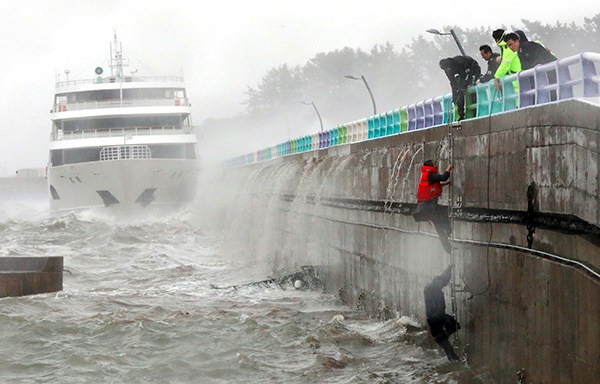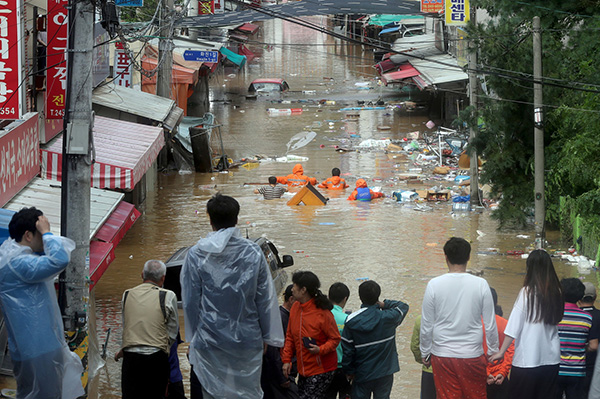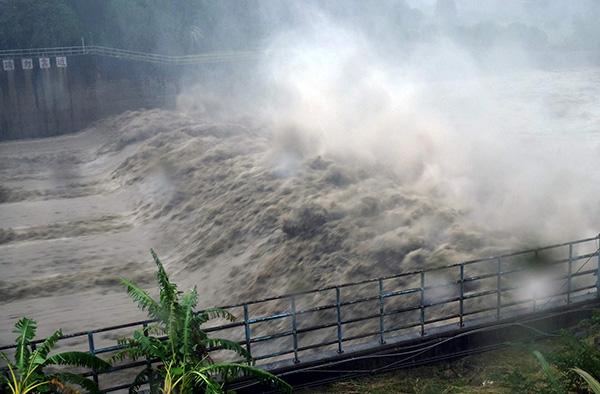
South Korean coast guards try to rescue crew members of a stranded passenger ship in the aftermath of typhoon Chaba in the southern city of Yeosu on Oct 5. – AFP photo
OFTEN we read about or see in the press or on television descriptions and images of a typhoon whipping up seas and flooding lowland areas as well as accounts of the aftermath.
Fortunately, I have only experienced the tail end of a typhoon in the late 1990s as, after its devastation in the Philippines, it hit western Sabah. There, and quite suddenly, the hotel dining room was turned into chaos by high wind gusts that whipped table clothes away, spilling china and glasses all over the place. The hotel staff rapidly closed all the window shutters and doors and battened down the hatches.
Behind the name
The word typhoon is thought to be derived from the Chinese word ‘tai fung’ or ‘dafeng’ or even perhaps from the Persian ‘tufan’. In all cases the translation means big wind. In the northwestern Pacific it means, at least, a severe tropical cyclone but in the northeast Pacific and north Atlantic oceans the word hurricane comes into play.
In the United Kingdom and Europe, hurricane force winds occasionally sweep in from the Atlantic, lashing the exposed western shorelines, but usually these are called severe temperate cyclones with warnings posted well in advance before they hit landfall.
How strong is a typhoon?
Interestingly, the Shanghai Typhoon Institute, which is part of the Chinese Meteorological association (CMA), uses various categories of wind speeds and includes Admiral Francis Beaufort’s wind force scale for mariners. Beaufort, the founding father of the British Meteorological Office, in the early years of the 19th century invented the Beaufort scale especially for sailors’ use.

A road is submerged in flood waters caused by Typhoon Chaba as residents look on in Ulsan, South Korea on Oct 5. – Reuters photo
How do they form?
As a form of cyclone, there is a combination of several factors that can create a typhoon:
l unstable atmospheric conditions with rising hot air
l high humidity levels in the lower troposphere
l the Cariolis force to create a low pressure centre and vortex
l warm sea levels of at least 26.5 degrees Centigrade down to a sea depth of 50 metres.
It is the latter that provides the heat to the atmospheric swirl of rising air and fuels the typhoon system attracting colder air from relatively higher pressure areas into the vortex of low pressure. The greater the difference between high and low pressure, the steeper the pressure gradient is and the faster the winds that are sucked into the cyclone.
The frequency of typhoons
Thirty-three per cent of typhoons are experienced in the western Pacific, peaking usually between August and October, although tropical cyclones may be observed at any time in the northwest Pacific Ocean. It has been found that typhoon tracks in El Nino years tend to drift over Japan but in La Nina events they shift westwards across the western Pacific hitting southern China and the Philippines.
Remarkable typhoons
In 1975, typhoon Nina swept over China causing the deaths of nearly 100,000 people as the result of severe flooding and the collapse of 12 reservoirs, so incessant and intense was the rainfall.
Typhoon Morakat, in 2009, submerged much of southern Taiwan with a total of 2,327 millimetres of rain recorded during its passage.
In 2013, the central Philippines was hit by super typhoon Haiyan with sustained wind speeds of 310km per hour.
More recently, severe typhoon Meranti in the middle of last month was recorded as the world’s strongest typhoon for this year at wind speeds of 170km per hour hitting Fujian province in southeastern China after earlier devastating southern Taiwan as a super typhoon at 216km per hour. Eastern Taiwan was hit again towards the end of last month by Typhoon Megi. This month Typhoon Chaba hit South Korea and Japan.
Widespread disruption was caused to transport networks through uprooted trees and collapsed electricity supply lines leading to the cancellation of train and airline services as well as power cuts.
Like all cyclonic systems as they pass over land surfaces so their energy is dissipated through friction with the ground surface. As they penetrate further inland so the rainfall decreases unless suddenly forced to rise by local hills or mountain masses.

Churning waters in the Jhihtan Dam is seen in Xindian district, New Taipei City, as Typhoon Megi hits eastern Taiwan on Sept 27. – AFP photo
Advice to travellers
l Study the meteorological forecasts of the countries that you intend to visit. These are easily available online from each country’s meteorological department. If an area is susceptible to typhoon events, listen to or read the daily forecasts.
l Batten down the hatches of your accommodation with all windows and doors closed and store any potential ‘flying’ objects in the garden.
l Be prepared for power cuts.
l If you have had enough warning, then ensure that you have collected a good supply of food and bottled water.
l Don’t venture out of the house for fear of touching dislodged electricity cables.
l Check that you are not staying in a lowland area which is susceptible to flooding by rivers or the sea.
Happy travelling in the out of typhoon season and let nature take its course.
